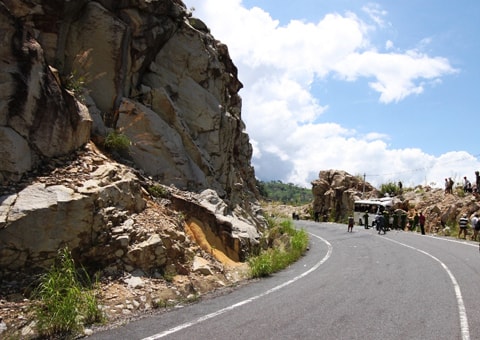Downhill driving skills to avoid 'losing your brakes'
Downhill driving experience requires calmness and especially limited use of brakes.
Many people may agree with the driver choosing the cliff instead of plunging into the abyss. But why don’t we choose a third place other than the two above, which is to drive on the asphalt road for safety?
Perhaps the habit of looking down on everything, showing off the ability to "drive silk" and the catchphrase "small things" have caused countless consequences for modern Vietnamese people, even though ancient Vietnamese people taught their descendants "prevention is better than cure"!
 |
If you drive downhill properly, cliffs and ravines are not places to crash. Photo: Lan Huong.
When going downhill, we need two things: a cool head and cold brakes. If we have... a cup of cold coffee, that would be great! First of all, don't think that the other car is "fake" than you and why it's going so fast, then try to "follow" it. A cool head would never do that. Cold brakes, never use them indiscriminately.
An experienced driver going downhill only uses 10% of the total braking time of a newbie, and they only brake when changing gears or when the car in front is running "banana" but never need to actively brake to slow down the car.
Just let the car drift and pull the engine, don't press the accelerator, keep your foot on the brake (but don't let it slide). If you see that the car pulling the engine is going too fast for the hill, press the brake and shift to a lower gear (because in this case the engine's resistance is weaker than the car's pulling force going down the hill). On the contrary, if it's a bit slow, shift to a higher gear to make it go a little faster, so that the car behind won't honk.
Normally, with small cars, gears 2 and 3 are for dangerous roads, gears 4 and 5 are for roads that are almost at the end of the slope, clear and straight, and only shift to gear 1 when it is special. Automatic cars use the corresponding semi-automatic mode. Another thing to note is that when going downhill at the fastest speed, you should not exceed 60 km/h if you want everything under control, and at the slowest, there is no limit, because depending on the slope and the angle of the turn, sometimes you have to "crawl".
Besides, remember that a hot head will definitely cause hot brakes. A cool-headed driver will never let the brakes burn out and have to choose a cliff or a ravine, they will just choose... the road!
However, there are also cases of force majeure, for example, a broken brake line, at that time, if there is no rescue route, the right cliff with the handbrake is the correct choice.
Press close to the cliff on the right but not into the ditch yet. If the vehicle speed is not too high, pull the handbrake slowly, you will stop on the road surface. If the vehicle speed is too high, you must let the 2 right wheels go into the ditch first and then pull the handbrake. If your vehicle has a low chassis, if the 2 right wheels go into the ditch, it will scrape the bottom and stop due to friction. The vehicle will be damaged but the person will still be there! Therefore, remember that cliffs and deep ravines are not places to drive, you should not choose either.
According to VNE
| RELATED NEWS |
|---|

